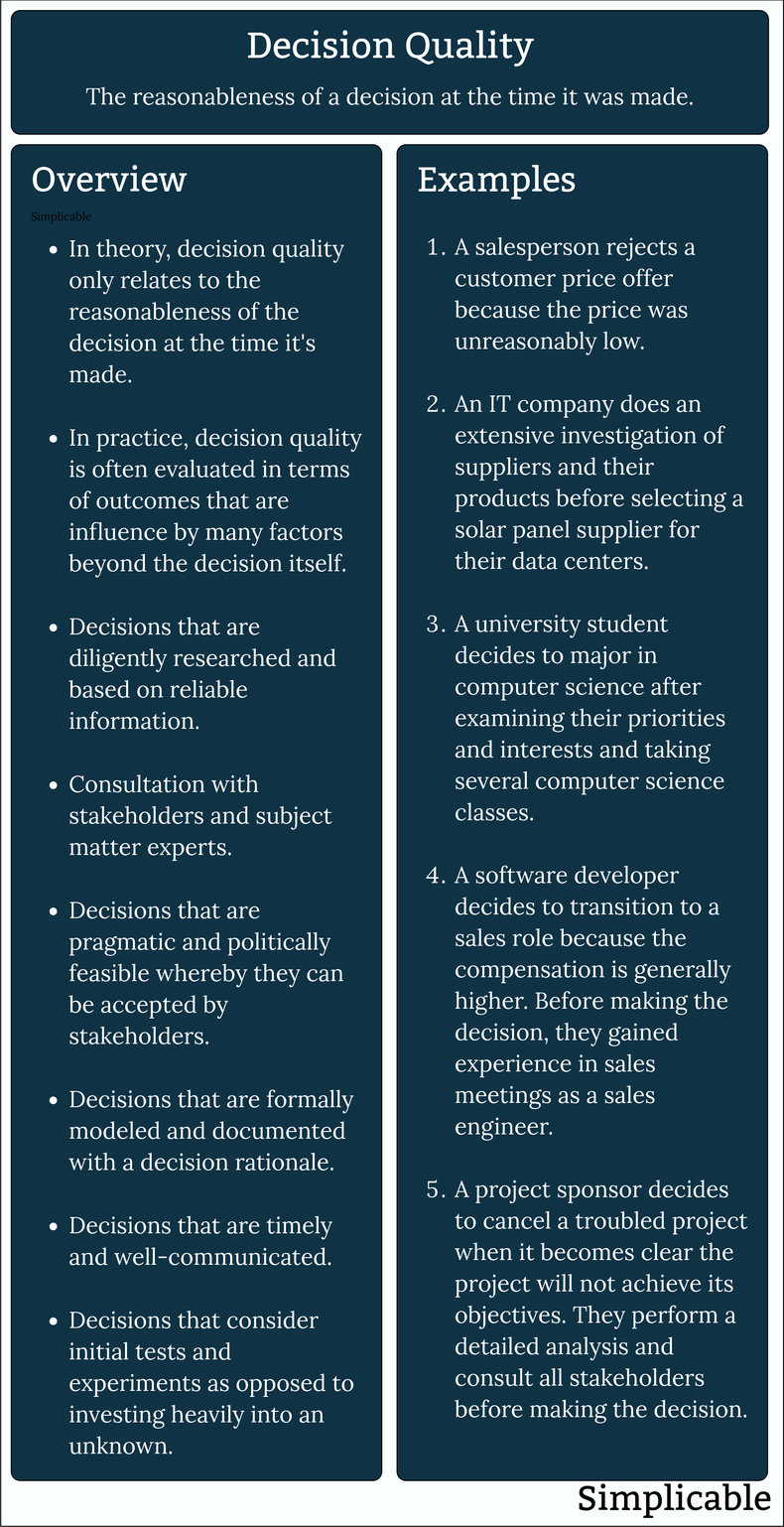
Framing
Decision making begins by defining the decision itself. A common failure of decision framing is to make assumptions or impose constraints that needlessly restrict your options. For example, a commuter might frame a decision as "What type of car do I need?" as opposed to "How will I get to work?" The latter leaves open options such as locating close to the office and walking to work in the morning. In some cases, constraints and assumptions do add value to a decision statement as they narrow down your options from the start. A wide open decision statement improves the chance of a creative solution while a constrained decision statement improves decision making efficiency.Timing
Making a decision at the right time. A decision made too early can result in a failure to adapt to change or new information. It can also be a waste of time and resources to make decisions that end up being irrelevant. Alternatively, making a decision too late can result in missed opportunities. If you decide you want to be a doctor when you're 14 years old, this may be too early as life experience may present you with other opportunities and more insight about your talents and weaknesses. If you decide you want to be a doctor at 40, this may be suboptimal as your peak ability to succeed in the profession may have past.Efficiency
Quality decisions are efficient. In some cases, a quick and cheap decision that is suboptimal can be considered higher quality than an expensive and slow decision that is closer to optimal. For example, a CEO of a mid-sized company becomes strangely engaged in a project to redesign an office interior. He ends up spending a total of 16 hours considering the color scheme for the office. This may neglect larger issues a firm is facing. As such, a reasonable choice of color scheme made in less than 60 seconds could be considered a higher quality decision.Due Diligence
Due diligence is the process of researching a decision to determine the facts that are relevant.Information Quality
Decisions are garbage in, garbage out such that a decision based on poor quality information tends to be poor quality. For example, if a patient is given inaccurate information about the side effects and probable outcomes of different treatment options, they may make a poor choice of treatment.Dealing With Ambiguity
Decisions often involve a large number of unknowns. The ability to make reasonable approximations and predictions to proceed with a decision in the face of uncertainty improves decision quality. Avoiding decisions or options that involve uncertainty can result in poor decisions. Likewise, low quality predictions and estimates can also result in poor decisions. For example, a stock market investor who makes overly optimistic predictions for the future revenue of a new product is likely to overvalue a stock.Imagination & Creativity
Analysis that steps beyond the obvious to consider new problems and solutions. It is a common failure of decision making to expect future problems and solutions to resemble the present.Alternatives
Decision quality tends to improve the more alternatives you consider. It is common to brainstorm large lists of potential alternatives as a starting point in any decision.Trade-offs
The process of modeling the trade-offs between alternatives including the merits, demerits, opportunities and risks associated with each path.Diverse Perspectives
Decisions benefit from diverse perspectives and ways of thinking. For example, a decision may begin with an optimistic process of freely generating ideas without validation and progress to a more pessimistic process of validating ideas.Objectivity
Decision makers who are motivated to make the best decision possible as opposed to having other motives influencing a decision. For example, a business decision motivated by office politics as opposed to business goals is typically low quality.Rationale
The rational thought that is applied to framing a decision, identifying alternatives, modeling tradeoffs and making a decision. For example, decisions made by a group through a process of consensus building may be viewed as irrational by each member of the group. As such, decisions may benefit from the influence of a leader who directs decision making along rational lines.Commitment & Acceptance
The degree to which individuals and groups accept a decision and are committed to making it happen. A suboptimal decision that is widely accepted can be of more value than a more logical decision that isn't accepted. For example, a government plan that completely solves an environmental problem may be of little value if it has no acceptance such that it is unlikely to be implemented. In this case, a plan that partially solves the issue that is widely accepted may be of more value.Sanity Check
Decisions may benefit from a sanity check such as the questions "does this feel right?", "will this really work?", "is this too crazy?" or "is this unimaginative?"Anti-patterns
Validation of a decision against common failures of rational thought such as biases and fallacies can improve decision quality.Overview
In theory, decision quality relates to the reasonableness of a decision at the time it was made. However, it is common to evaluate decisions purely in terms of outcomes whereby a bad decision was good if it works out well and vice versa.
| Overview: Decision Quality | ||
Type | ||
Definition | The reasonableness of a decision at the time it is made. | |
Related Concepts | ||



































